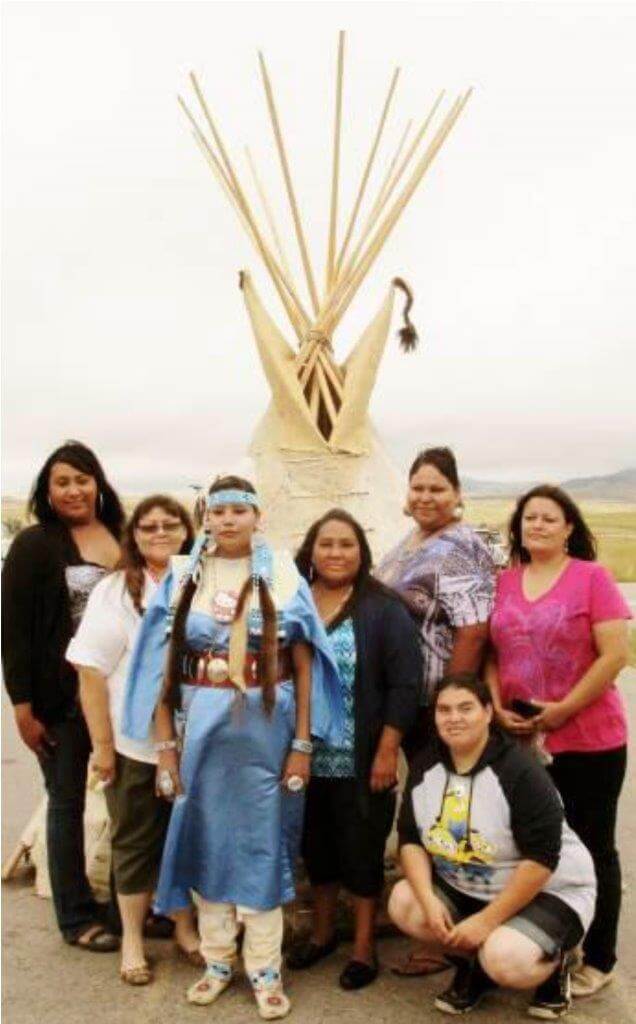
These women came to the Vore Jump from Lame Deer, Montana, to make a tipi on site, in the old ways they had learned. From left: Tee Jay Littlewolf, Lori Killsontop, Larie Clown, Rebekah Threefingers, Maria Russell, Jodi Waters; kneeling is Victoria Haugen.
A special event took place at the Vore Buffalo Jump site in 2014 when the Foundation Board decided they wanted a tipi. Not just any tipi, but a fully authentic one. And the buffalo hides had to be tanned in just the way women tanned them and sewed them together long before they had horses.
They hold high standards. Vore Buffalo Jump leaders have tried to adopt and use ancient Native American methods and authentic Native tools in their work when possible.
That meant the tipi had to be small enough and light enough to be hauled by one or two dogs. So why not find Native women to do it?
They soon discovered that the well-known expert in the art was closer than they imagined. The ancient technique was being taught at Chief Dull Knife College in Lame Deer, Montana—not so far away. And a class of Northern Cheyenne women in the college was studying just that.
Seven Cheyenne women agreed to come and make the tipi in the old way on the Wyoming site.
The last tipi made by the Northern Cheyenne was around 1877—when herds of buffalo were on the verge of extinction and reservations were being established.
They said they’d be delighted to come, tan the hides and make the proper kind of tipi needed..
In fact, for these women it would be “A dream fulfilled!”
The women who came were Larie Clown, Victoria Haugen, Lori Killsontop, Tee Jay Littlewolf, Maria Russell, Rebekah Threefingers and Jodi Waters.
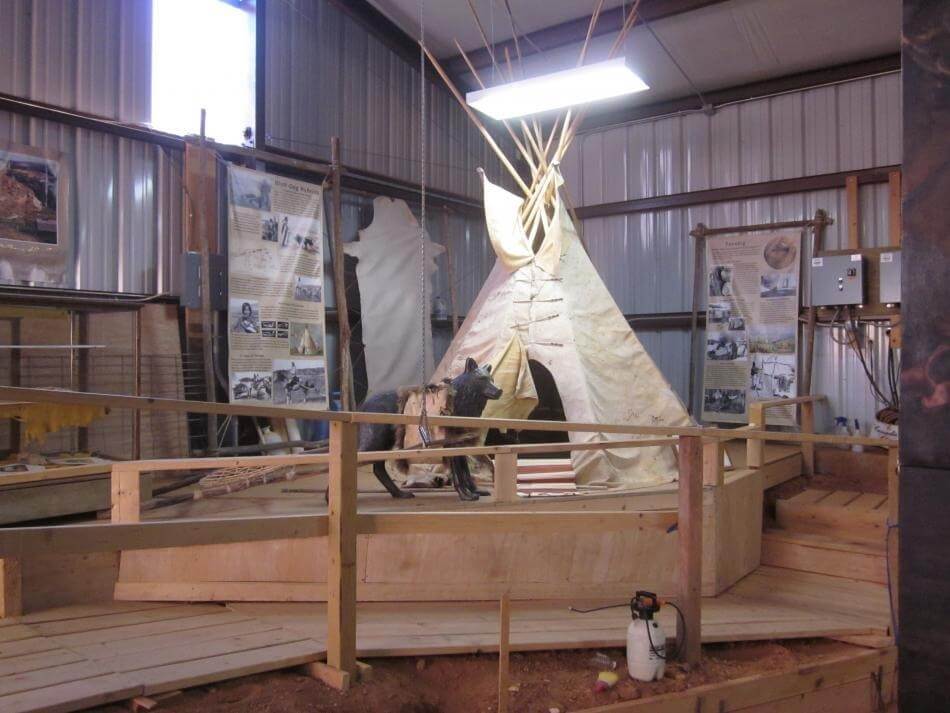
The new tipi found a home in the big building down in the sinkhole. Note tipis pulled by dog travois were smaller than later when they had horses to haul their belongings. This tipi weighed about 90 pounds so would probably be pulled by two dogs.
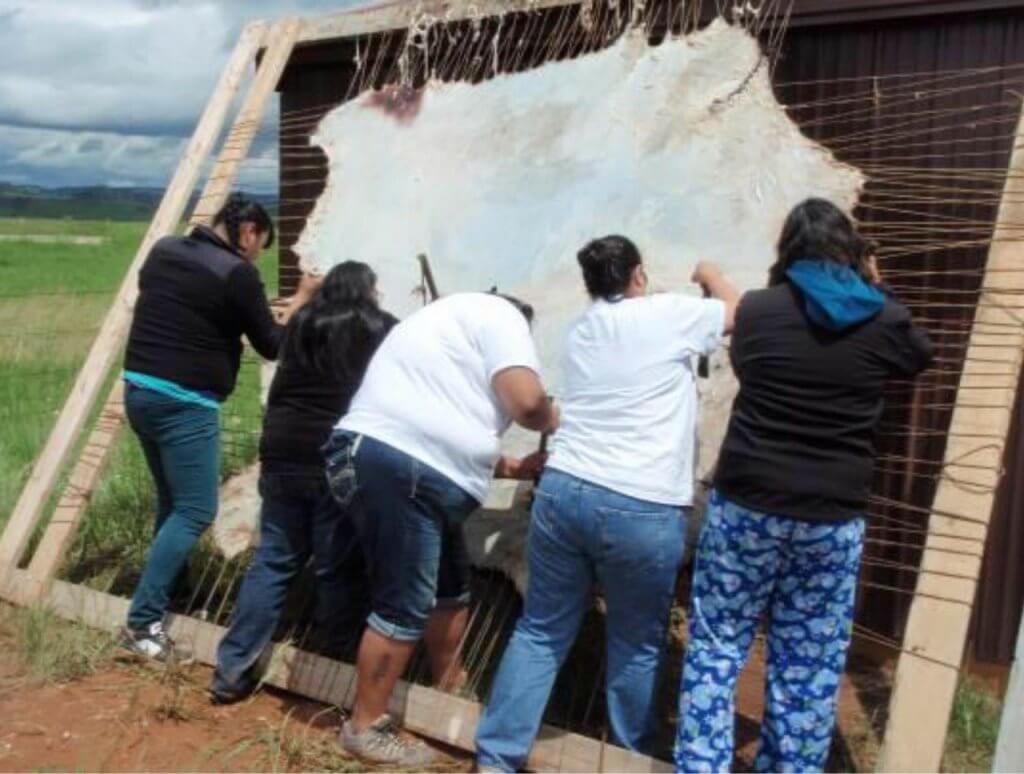
The morning of June 11, the women began the task of tanning the first buffalo hide. They needed five buffalo hides for a complete tipi.
The hide was laced onto a frame so the women could use buffalo leg bone fleshers to remove fat and meat from the skin. After the hide had dried and become stiffer rawhide, the hair (wool) was scraped off using an elk horn scraper.
In an article he wrote for the Vore Buffalo Jump Foundation Gene Gade, then president, wrote that few tasks were more labor intensive—or necessary—than processing the skins of buffalo and other animals into tanned leather and then using it to produce all kinds of essential products including clothing, tipi covers, moccasins, storage bags and many other items.
It was a time‐consuming job, performed almost entirely by women.
All tribes in the region were using some form of “brain tanning” by the time the Vore Site was used. It’s a technique that early people throughout the world discovered, in one variation or another. He explains that without this treatment the hides would have quickly become rancid and start to decompose.
The brain contains oil called lecithin that becomes a natural tanning agent to lubricate the skin. If you intend to make the hide into a blanket or warm winter coat, only one side of the hide needs to be scraped, because the hair doesn’t have to be removed. The hair was left on and the hide left to dry, stretched and taut.
But if you plan to make a tipi cover or use it as leather, all the hair must be removed. Soaking it in water up to three days, loosens the hair and raises and softens the grain layer of the hide..
Because brains “mix oil and water,” they form a stabilized emulsion on the hide. Nearly all buffalo skulls at the Vore site, Gage said, have been bashed open to remove the brain for hide tanning purposes.
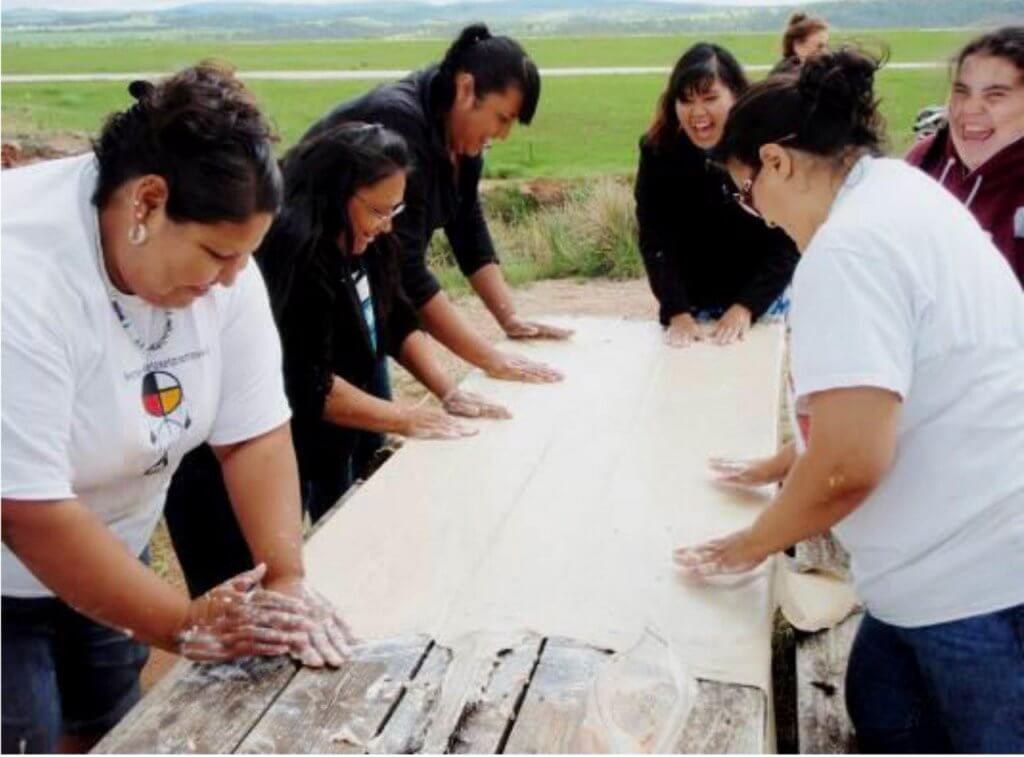
The next day the rawhide was soaked in water to make it more pliable and buffalo brains were rubbed into the hide.
The first priority after a buffalo jump that killed many buffalo was to process the tons of meat that would otherwise spoil quickly. Hides were usually tied in bundles and set aside or soaked in water while the meat was being dried and preserved.
Then the arduous process of “Soak and Scrape, Soak and Scrape!” began, says Gage. After first soaking and cleaning, the next critical step was to thoroughly scrape away any flesh, fat, muscle or connective tissue from the hide—a job the women usually did on their knees.
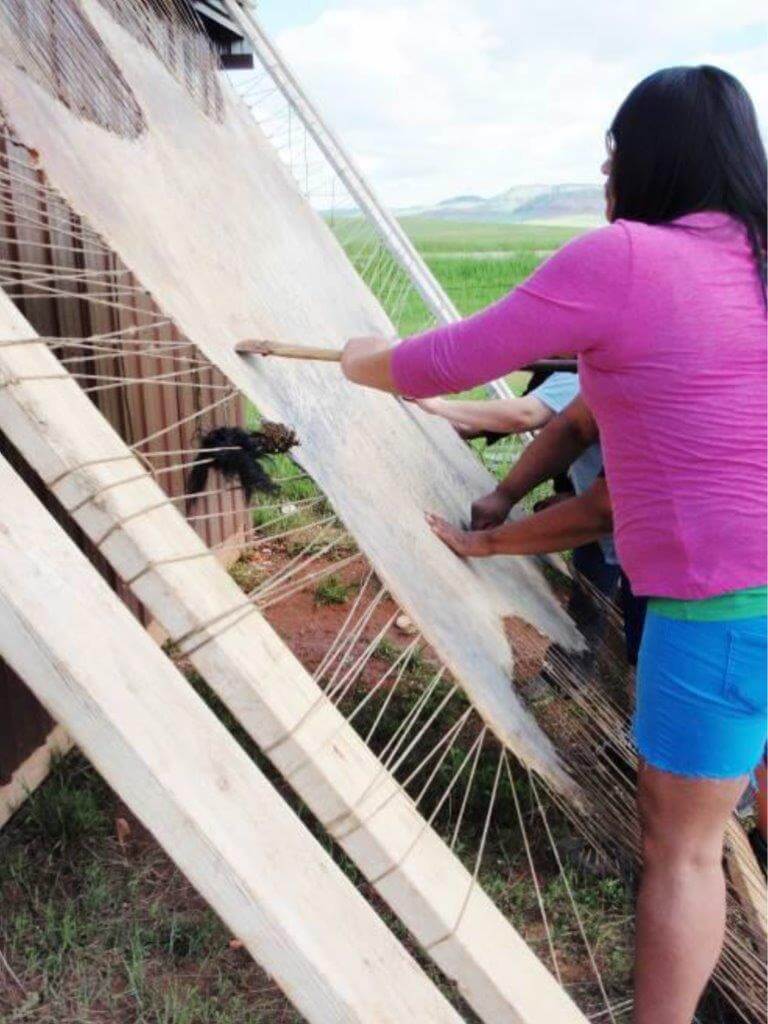
After brains had time to soak into the skin, holes were made in the hide, and it was laced onto a frame using sinew. The hide was pushed and staked to stretch the fibers so the skin would be soft and not stiff when completely dried.
After working the skin for hours on the frame, the hide was unlaced and another technique stretched the hide: the hide was used to toss youngsters into the air. Such a sport was enjoyed a century earlier.
As a child sat in the center of the robe, those holding the edges of the hide pulled in unison to send the child up into the air. After a dozen tosses, another child got a turn. This unique method stretched the hide and thrilled the children!
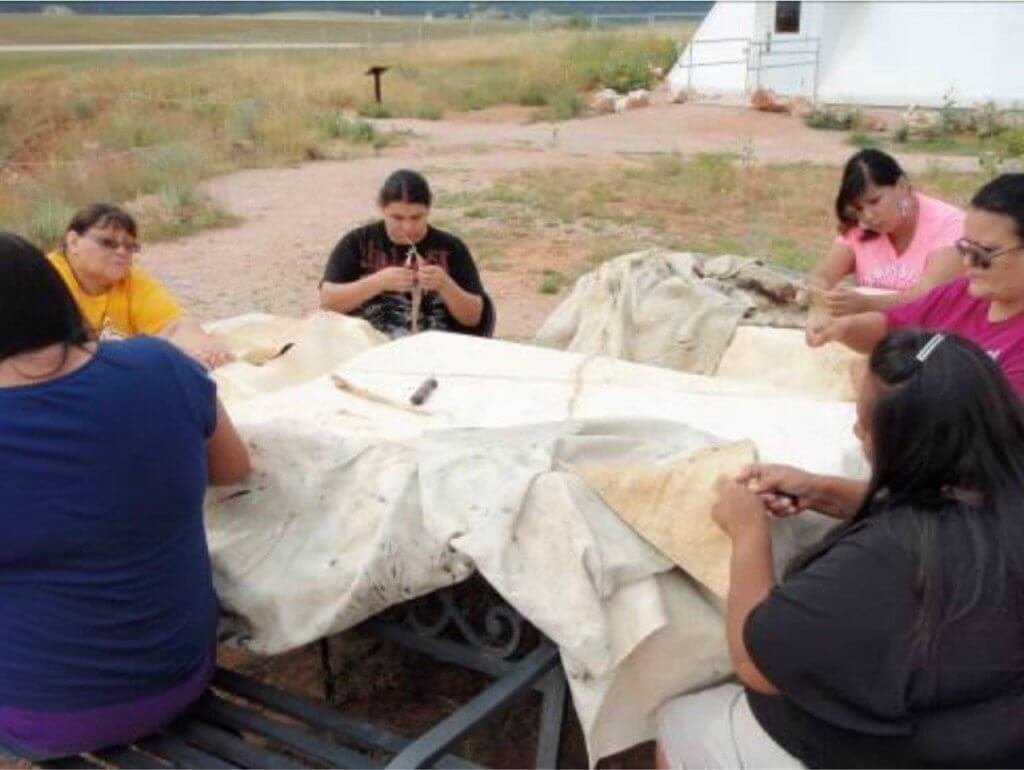
The Cheyenne group returned in August to sew the hides together in a half circle, which took three days. The sewing involved poking holes with an awl, and the hides were sewn together at their edges using sinew as thread.
The students then used sinew to stitch five hides together to construct the tipi. Their one concession to modern times was the use of metal needles. Sewing the hides together took three days.
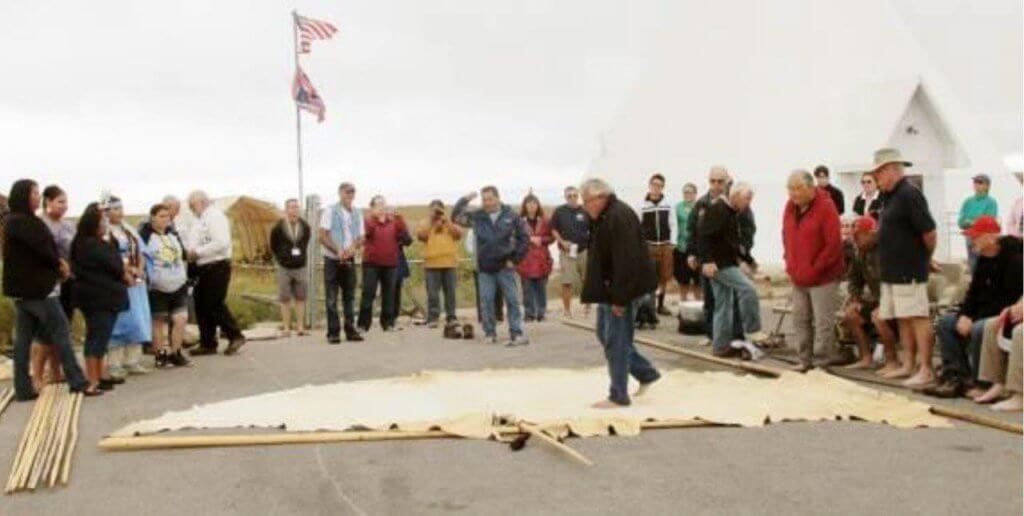
Lodgepole pines were cut and peeled, chokecherry lacing pins carved and a buffalo hide tying robe braided to complete the tipi.
On the morning of the dedication, the tipi was traditionally honored by having military veterans walk barefoot across the tipi cover while an honoring song was sung. Cheyenne elders spoke about the importance of this tipi.
The women next set up the pole framework, wrapped the hide cover around the poles, pinned the right and left sides together and inserted smoke flap poles.
Alan Blackwolf, Keeper of the Northern Cheyenne Sacred Buffalo Hat, then smudged the tipi.
Accompanied by drumming and singing by two Cheyenne elders, the group danced in a circle to a Friendship Dance.
For the Northern Cheyenne women, they had accomplished their mission. They were happy and proud of what they had done— ‘A Dream fulfilled!”
Buffalo hides, travel and refreshments had been rather costly. But the Vore Foundation Directors had been able to get grant funds and donations together to do it right.
So the tipi was constructed on site by students as planned, accompanied by an instructor from Chief Dull Knife College under the guidance of Larry Belitz, one of the few experts in the art.
“To bring this long-sought dream into reality required the effort of the Cheyenne workers, Larry Belitz who directed the tipi-making, and behind-the-scene work of Vore Buffalo Jump Board of Directors,” said Jackie Wyatt of the VBJF, who lives in Sundance WY.
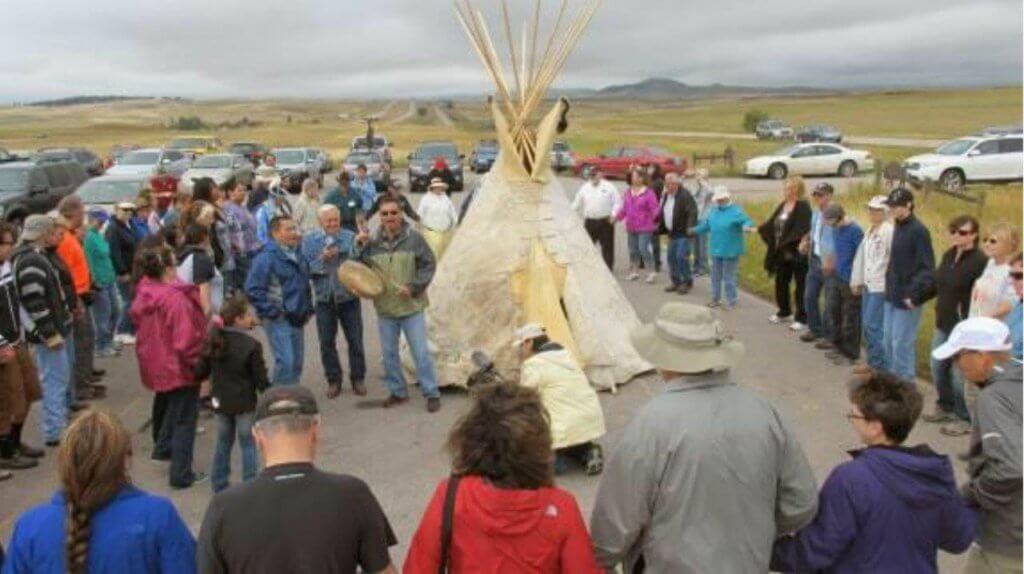
In a closing ceremony, visitors and local people joined hands around the new tipi for a prayer and friendship dance
This kind of tipi—made with five buffalo hides—was used by Plains tribes before they had horses. Once the Plains hunters obtained horses, their tipis could become much larger. This one weighs about 90 pounds so it likely would have taken two dogs to pull the travois.
When finished, the new tipi found a home in the large research building down in the Vore sinkhole, where it now provides inspiration to researchers and volunteers as they work to excavate new layers of bones and develop new educational panels.
Funding for the project came from the Wyoming Cultural Trust Fund, the Wyoming Humanities Council, the Shakopee Mdewakanton Sioux Community and donations. Photos credit Vore Buffalo Jump Foundation. See also “The Ancient and Arduous Art of Brain Tanning Buffalo Hides” by Gene Gade.
NEXT: STUDIES FOR SCHOOLS
______________________________________________________________________________

Francie M Berg
Author of the Buffalo Tales &Trails blog


